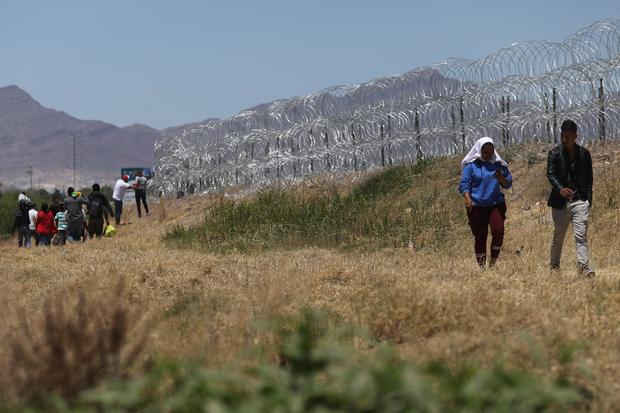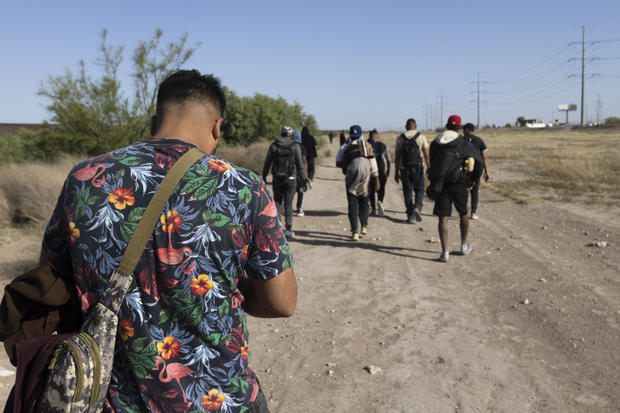El Paso, Texas — The Biden administration has finalized a sweeping restriction on asylum that it plans to use to ramp up swift deportations of migrants who cross the U.S.-Mexico border after the Title 42 pandemic-era emergency policy sunsets on Thursday, according to internal documents obtained by CBS News.
Hundreds of U.S. asylum officers were trained on how to enforce the restriction on Tuesday and the regulation was published on Wednesday, less than 48 hours before Title 42 is set to expire. CBS News first reported the regulation’s finalization on Tuesday, as well as the guidance issued to asylum officers charged with implementing it.
The regulation, which is expected to be challenged in federal court, will be a dramatic shift in asylum policy, disqualifying migrants from U.S. protection if they fail to request refugee status in another country, such as Mexico, on their journey to the southern border.
HERIKA MARTINEZ/AFP via Getty Images
The rule also represents a major pivot by President Biden, a Democrat who campaigned on restoring access to the U.S. asylum system after numerous Trump administration rules made it more difficult for migrants to secure refuge on American soil. In fact, the regulation published Wednesday resembles a Trump-era policy struck down in federal court that Mr. Biden decried in 2020.
If upheld, the Biden administration’s rule will cement a growing bipartisan rejection of the asylum laws that Congress enacted in 1980 to conform with international treaties designed to prevent nations from turning away refugees to places where they could be persecuted, as the U.S. did to some Jews fleeing Nazi Germany.
The years-in-the-making shift has intensified recently, as historically high levels of migrant arrivals have further strained a massively backlogged asylum system, overwhelmed border communities and created a political liability for Mr. Biden ahead of his re-election bid.
Under the rule, migrants who cross the southern border without authorization will be presumed to be ineligible for asylum if they can’t prove they previously requested protection in a third country. In practice, it will disqualify most non-Mexican migrants who enter the U.S. between ports of entry from asylum.
Migrants who secure an appointment to enter the U.S. under a mobile app-powered system will not be barred from asylum under the policy. The rule will also not apply to unaccompanied children.
According to internal training documents, only migrants with “exceptionally compelling circumstances” will be able to overcome the rule’s asylum bar. Those include migrants with an “acute medical emergency,” those who face an “imminent and extreme threat” in Mexico and victims of “a severe form of human trafficking.”
In order to avoid being deported and banished from the U.S. for five years, those who don’t qualify for any exemption will need to pass interviews with heightened standards designed to lead to more rejections than traditional “credible fear” interviews, according to the training materials.
The restriction is the centerpiece of the Biden administration’s attempt to blunt a potentially historic increase in the number of migrants crossing the U.S.-Mexico border when the Title 42 expulsions are discontinued at midnight on Thursday. Unauthorized border arrivals have already spiked, with Border Patrol averaging more than 8,700 daily migrant apprehensions during a three-day period this past week, an increase from the 5,200 average in March.
While Title 42 allowed U.S. border officials to cite public health concerns to expel hundreds of thousands of migrants without hearing their asylum claims, the new rule is, in many ways, a tougher policy. Because migrants expelled under Title 42 did not face immigration or criminal penalties, the measure encouraged some to make repeated border crossing attempts.
But those who can’t prove they are eligible for an exemption to the new rule will face swift deportation to Mexico or their home country — as well as a five-year banishment from the U.S. — under a process known as expedited removal. If they try to re-enter the U.S. after being deported, they could face criminal prosecution and jail time, the Biden administration has warned.
David Peinado/Anadolu Agency via Getty Images
Biden administration officials have said the asylum restriction was not their first or second “preference,” but have justified the move by citing the record levels of migrant apprehensions reported by U.S. border agents over the past two years. Without the rule, the administration has said, the number of migrants crossing the southern border each day could soar to 13,000 after Title 42’s end.
The administration has also argued the rule will encourage migrants to enter the country legally, including through a phone app that lets asylum-seekers in Mexico request U.S. entry, and a sponsorship initiative that allows up to 30,000 Cubans, Haitians, Nicaraguans and Venezuelans with American sponsors to fly to the U.S. each month.
“President Biden is leading the largest expansion of legal pathways to protection in decades and could be doing a whole lot more if Congress would let him,” White House spokesman Abdullah Hasan said Tuesday.
While the partial asylum ban has garnered support from some centrist Democrats, it has been strongly repudiated by advocates, progressives and former Biden officials, who argue the policy ignores U.S. asylum law, under which migrants on American soil have a right to request refuge, regardless of how they entered the country.
“It is a profound shift for a Democratic president to implement a new ban on asylum-seekers,” said Andrea Flores, who served as a White House border official during the first year of the Biden administration. “It’s evidence that the past decade of far-right attacks on Black and brown asylum seekers have significantly weakened the Democratic Party’s commitment to providing refuge to people fleeing persecution and torture.”
The American Civil Liberties Union, which convinced federal courts to block the Trump administration’s “transit ban” on asylum, has pledged to also file a lawsuit against the Biden administration’s rule.
“We will sue as we did under Trump,” Lee Gelernt, the ACLU’s top immigration lawyer, told CBS News Tuesday. “The core illegality is the same.”
During one of the 2020 presidential debates, Mr. Biden denounced former President Donald Trump for being “the first president in the history of the United States” to declare that “anybody seeking asylum has to do it in another country.”
But soon after Mr. Biden took office, his administration considered doing just that amid a rise in border crossings. The regulation, however, was rejected in 2021 amid opposition from some appointees and a determination by the top White House lawyer that the measure could have been struck down in court.
The Biden administration has strongly denied that the regulation finalized on Wednesday is similar to the Trump asylum ban, arguing that its approach is different because its restriction has broader exemptions and is being paired with expanded channels for migrants to enter the U.S. with legal permission.


